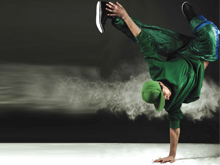Health Topics
-
Healthy Living
-
|
|
July 2011
|
| Sports Injuries: Through a Dancer's Lens |
| Aleksandar Josipovic |
| |
 |
For many people, dance is not a sport. But to dance is to move to a level far beyond athleticism. There is speed, power, balance, and endurance – all the things that define an athlete. But, what about the ice skaters and gymnasts – there seems to be such a fine line dividing them and the dancers! |
With the high physical demands of their profession, dancers are also as susceptible to injuries as are football players. As the majority of professional dancers begin dancing at the age of five or six, the repetitive practice of movements that require extreme flexibility, strength, and endurance make them prime candidates for overuse injuries.
Two Major Injuries
Sports injuries can be broadly classified as either traumatic or overuse injuries. Signs and symptoms are generally the same - inflammation is characterised by pain, localised swelling, heat, redness and a loss of function.
For dancers, injuries tend to occur at the foot, ankle, lower leg, low back, and hip, with the frequency often being in that order. The foot/ ankle/ lower leg area is vulnerable to a wide range of injuries, including stress fractures, tendon injuries, sprains, and strains. These injuries show up with greater frequency in dancers as they age, so it is extremely important to emphasise what the young dancer can do to prevent future injuries.
Other types of injuries can be caused by a hard contact with something. This can often cause a broken bone or torn ligament or tendon... which of course is very, very painful!
What Causes Injuries
It is generally acknowledged that all athletes are exposed to a wide range of risk factors. The most common things that cause dance injuries include:
- The type of sport, dance
- Frequency of classes, rehearsals, sport sessions and performances
- Duration of training
- Equipment used, example, type of shoes
- Body alignment
- Prior history of injury
- Nutritional deficiencies
- Not warming up, being the most common of all
Warm Up
Prepare yourself for any intense activity by doing a similar activity less intensely. In other words, start slow! To warm up your tissues and muscles, you need metabolic activity – the heat causes physical changes in connective tissues that make them more pliable. You need to start slow and warm up. After that you can go into action... or to your dance class.
Warm-up can include:
- 5 to 10 minutes jogging - to increase body temperature.
- 10 to 15 minutes of dynamic stretching exercises - reduce muscle stiffness.
Your performance will improve, as an appropriate warm up will result in:
- Increased speed of contraction and relaxation of warmed up muscles.
- Dynamic exercises reduce muscle stiffness.
- Greater economy of movement because of lowered viscous resistance within warmed muscles.
- Facilitated oxygen utilisation by warmed muscles, because haemoglobin releases oxygen more readily at higher muscle temperatures.
To Prevent Dance Injuries
- Wear properly fitting clothing and shoes. Wear appropriate protective gear and equipment. There is a reason why we are calling them PROTECTIVE.
- Drink plenty of fluids.
- Resist the temptation to play and perform through pain. If the pain is present, listen to your body and ask your doctor for advice and help.
- Pay close attention to your session at gym, advice of your personal coach or dance teacher. Ask yourself how you are doing your gym programs.
- Be very mindful of the limits of your body.
- Rest: Athletes with high consecutive days of training have more injuries. While many athletes think the more they train, the better they'll play – this is a misconception. Rest is a critical component of proper training. Rest can make you stronger and prevent injuries of overuse, fatigue and poor judgment.
- Perform proper warm-up exercises.
- Perform proper cool-down exercises.
Cooling Down
Cooling down should consist of:
- 5 to 10 minutes jogging/walking - decreases body temperature and removes waste products from the working muscles.
- 5 to 10 minutes static stretching exercises. Static stretches are more appropriate to cool down as they help muscles to relax, realign muscle fibres and re-establish their normal range of movement.
The benefits of cooling down include:
- Aiding the dissipation of waste products in the muscles.
- Reducing the chances of dizziness or fainting caused by the pooling of venous blood at the extremities.
- Reducing the level of adrenaline in the blood.
- Allowing the heart rate to return to its resting rate.
The medical professional plays a significant role in not only treating and rehabilitating the injuries athletes incur, but also in preventing them.
A special word should be said for the role of physical therapists, certified athletic trainers and other allied health professionals who initiate and facilitate screening sessions for you. These screening procedures help identify potential problems and prevent future injuries. |
| |
Aleksandar Josipovic is a Serbia-born,Paris-based multimedia artist , dancer,dance professor,life coach,NLP therapist and author.He is also a regular performer at the famous Moulin Rouge in paris.His works can be accessed at www.aleksandarjosipovic.com |
|
|